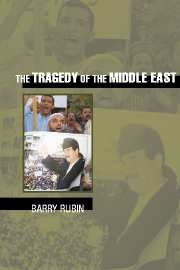Book contents
- Frontmatter
- Contents
- Preface
- 1 The Triumph of the “Old Middle East”
- 2 Paradigm Lost
- 3 The Regime's Success, the Nation's Disaster
- 4 Syria: The Test Case for Reform
- 5 Iran: The People versus the Will of God?
- 6 Force and Violence in Middle Eastern Politics
- 7 The Battle for the Soul of Islam
- 8 The Arab-Israeli Conflict: Foundation Stone or Millstone?
- 9 The Truth about U.S. Middle Eastern Policy
- 10 The Uncivil Society and the Wall of Lies
- Index
8 - The Arab-Israeli Conflict: Foundation Stone or Millstone?
Published online by Cambridge University Press: 05 August 2012
- Frontmatter
- Contents
- Preface
- 1 The Triumph of the “Old Middle East”
- 2 Paradigm Lost
- 3 The Regime's Success, the Nation's Disaster
- 4 Syria: The Test Case for Reform
- 5 Iran: The People versus the Will of God?
- 6 Force and Violence in Middle Eastern Politics
- 7 The Battle for the Soul of Islam
- 8 The Arab-Israeli Conflict: Foundation Stone or Millstone?
- 9 The Truth about U.S. Middle Eastern Policy
- 10 The Uncivil Society and the Wall of Lies
- Index
Summary
For fifty years the Arab-Israeli issue often appeared to be the single most important feature of Middle Eastern politics. Seemingly unsolvable, it sparked seven major violent conflicts. Yet, gradually and reluctantly, most Palestinians and Arab states seemed to be reassessing their goals in order to accept a land-for-peace solution instead of seeking Israel's destruction. This shift, in turn, made possible changes in Israeli policies and public opinion that opened the way to a peace process.
Realizing the inability to solve the conflict through force should have been a major step toward reaching a peaceful resolution. Only when both sides perceived that neither Israel's destruction nor the Palestinians' permanent exile and political extinction would happen could the parties involved become ready for a two-state solution, giving each side a national framework. Equally, the conflict's apparent endlessness, incurring high costs with no prospect for absolute victory, made success at the bargaining table seem both plausible and desirable.
In general, the basis of the peace process was supposed to be the Palestinian and Arab conclusion that the conflict's costs exceeded its benefits and that a compromise, negotiated outcome was the best they could do. But were these assumptions true? If the conflict was a millstone around the Arab world's neck, then ending it made eminent sense. But if it was a foundation stone for the existing Arab system, it had a value going far beyond the immediate issues involved. In that case, no war, no peace was preferable to either war or peace.
- Type
- Chapter
- Information
- The Tragedy of the Middle East , pp. 193 - 226Publisher: Cambridge University PressPrint publication year: 2002



